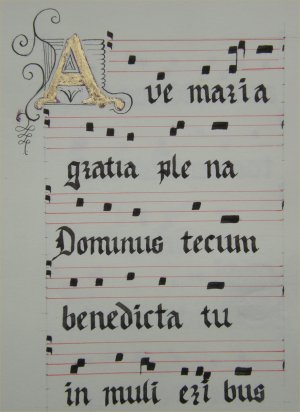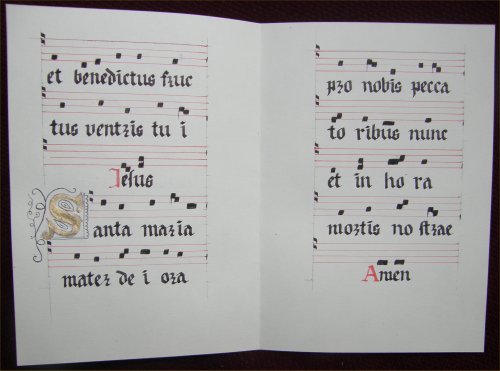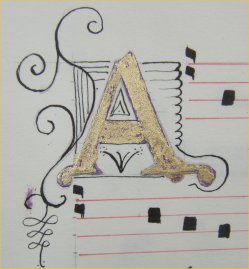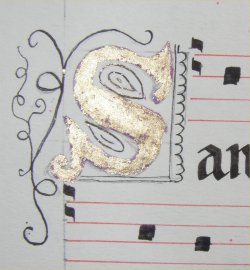 |
|
November Crown Tourney ASXLIV[Site Dressing] [Combatant Hangings] [The Tournament] [Antiphon: MS] [The Bells, The Bells!]See other Crown Tourney-related activities: [Vade Mecum] [Crown and King] [Flags and Water Bottles] [Antiphon] [Crown Broadside] Southron Gaard hosted its first-ever Crown Tournament in November ASXLIV, and we were determined to make it more than just another tourney. As Pageantry Steward, I was tasked with dreaming up ways of doing this, ideally using or adapting the extensive resources available to Southron Gaard and making best use of the ideas and skills of the populace. The first inspiration was the illustrations of period tournaments from Barber and Barker's Tournaments book and Rene of Anjou's Tournament Book, which depict covered galleries of seating, decorated list fields and lots and lots of decoration, most notably standards and banners. Could we produce something comparable? Yes, yes we could. Then it was a matter of seeing how many additional touches we could come up with.... Site Dressing
The initial scene-setting was relatively easy. We had a great site in the Canterbury Faire venue, and a local holiday meant that we could offer an extended three-day event to make it worth while to travel to our barony -- many of the Crown Tourneys I have been to are pretty much one-day events, which makes the economics of travelling hard to justify. It soon became clear that we could attain a Rene-style layout relatively easily. The three baronial sunshades and Lord Henri's small marquee, along with the Baronial Pavilion could form three sides around the beautiful list field built by Sir Sigurd and Baroness Eleonora. And the "Massard facade" -- the large wall that Sir Vitale and Lord Raffe de Massard built for their encampment -- was just the thing for the final side, providing a place to erect banners, a gate to march though, and a tall turret from which to fly the Kingdom flag.
Anabilia and Lord Thorald pledged to provide a frontal for the galleries, depicting the arms of all the groups in the Kingdom. Though they did have other things to do, like stewarding the event...They were still painting frantically on the day, with the help of Lady Katherine Stewart, and the frontal sections came down from the hall one by one as each was touch-dry. Three of the planned six made it to the field and they looked glorious. The good people of the Shire of Darton to our north generously provided miles of bunting, their cloth of estate and yet more silk flags to dress the area. I appropriated the large wooden frame that is used for bridge battles at Canterbury Faire and, by the time we covered it in rich fabric and hoisted the cloth of estate over it, we had a suitably regal platform for Their Majesties and Their Excellencies of Southron Gaard. The populace got raised seating too, as Lord Raffe arranged for us to use bleachers to provide a solid platform for forms, again covered in fabric.
Combatant HangingsI had a large collection of calico, in two-metre lengths, just perfect for some kind of hanging. The impresa image I'd used as part of my family papers project provided inspiration for a set of combatant hangings. We could draw the tourneyer and their shield as a standard motif, then paint in the arms.
A couple of sessions with an OHP and helpful hands produced a batch of outlines, and over the course of several months I got the shield artwork done. Lady Inge kindly hemmed the hangings and we were good to go. The idea was that we could put them along the wall that formed one end of the tourney field. As fighters fell, their hanging could be removed, making it something like a list tree write large. I had considered doing an extra-large drawing, based on the Nuremberg Tournament book, and having a set of stencils for all the fighters prepared so that we could paint in the arms of the Tourney winner on the day. That proved a tad ambitious, so I went for Plan B which was to prep two shields with the Prince of Lochac's arms on them (the Royal Arms with the label). It would be a relatively simple matter to slip-stitch them onto the horse's barding, once we knew which hanging belonged to the winner. I also had some red ribbon so that I could write the name of the winner and his consort on and tack it to the hanging for a bit of additional bling. The TournamentI had looked at the ceremonies on the Lochac Herald's site and they seemed a little flat and a tad outdated. The Shire of Darton had run two May Crowns in a row and had clearly modified the material, also based on Rene de Anjou, so I figured combining the period and the SCA traditions would be a reasonable approach. Mistress Marienna kindly sent me the ceremony that Darton had used. The final edited material was presented to Their Majesties for approval, along with a range of options to suit Them and Their schedule.. Formal Announcement of TourneyQueen (or via Herald reading from text): King: Herald: Let all princes, lords, ladies, knights and squires in the baronies of Rowany, Aneala, Innilgard, River Haven, Stormhold, Ynys Fawr, Politarchopolis, Southron Gaard, St Florian de la Riviere, Ildhafn and also Mordenvale, and all others of whatever shires, colleges and other gatherings of the populace that are in this kingdom, who are not banished or enemies of the king our lord or the queen our lady, know that on the morrow in the Barony of Southron Gaard, there will be a very great festival of arms and a very noble tourney with rebated weapons, in appropriate armour with coats of arms and banners of the arms of the noble tourneyers as is the ancient custom; and each contestant shall for this tournament have a named consort. Of which tourney the captains are the very noble and powerful princes the Queen appellant and the King defendant; And at the tourney there will be the noblest prize of all, for the winner and their consort shall be crowned Prince and Princess of the Kingdom of Lochac. It was great having this done the night before we sang Lowrens' antiphon, as he used the same words in the plainchant part of his piece. Herald: Invocation CourtTheir Majesties and their attendants, along with the Marshal, the Herald, and two younger members of the populace bearing a King's and Queen's banner each (and wearing lion and unicorn masks respectively) processed through the wall gate and onto the field, to the sound of a shawm processional.
Herald: Herald: Barons, lords, knights and squires, take up, take up, take up your helms and come out with your consorts to gather at the feet of Their Most Puissant Majesties of Lochac. A shawm fanfare sounded, then the Tourney Herald, Benedict of Askerigg, called the combatants and consorts in order of precedence, with the call echoed at the wall end of the field by Lord William de Wyke. As each pair stepped through the gate, they were showered with rose petals and their standard was raised on the wall, with fighters moving to the King's side and Queen's side. Their hangings went up on the wall as their sides were confirmed.
OathsKing: Herald: You have all heard the conventions of combat for this tournament, and you all know the Rules of the Lists. Do you swear to abide by these rules and these conventions during these Lists? Comb: Herald: Comb: Herald: And do you swear that you and your consort can and will fulfil the duties and obligations of a King or Queen of Lochac, and that you will rule justly and to the utmost of your abilities, as long as you shall reign? Comb: Queen: Herald: And do you swear that you and your consort can and will fulfil the duties and obligations of a King or Queen of Lochac, and that you will rule justly and to the utmost of your abilities, as long as you shall reign? Consorts: ChallengesHerald:
Final InvocationHerald: Bear no stone in this Tournament that may act as a talisman for victory. Yet you all bear the cornerstone of our Kingdom on the field this day. Let your Honour be a rock on which all your deeds stand. Bear no Amulet today hoping for victory by it's worth. Yet you must display for all a token by which you are measured. Let your skill at arms and prowess on the field be the badge by which all know you. Bear no herb of virtue that by sweet essence victory will be yours. Yet beauty must temper the struggle of arms and clash of combat. Let the favours you bear and the grace of those who inspire you be your guide this day. Then, let Honour, Skill at arms and Inspiration be the Hallmarks of our tourney this day. Let them be displayed proudly by all who fight here, whether as bright coin to purchase victory or earnest medallion remembering honourable defeat.
Queen: King: Herald: As each combatant fell, we took down their standard and hanging, until at the end only two were left.... Antiphon: MSThis was one of the categories for the Kingdom A&S Comeptition at November Crown Tourney. I did this antiphon by hand, and one as a late-period printing project. I had intended a third, based on the earliest surviving Scottish music manuscript, but ran out of time. Still in the pipeline... The title of the category was "Antiphonal – Illuminated church music -- including missals and graduals", which really is a bit of a mish-mash. Church music was collected in a variety of forms to ensure that the various part of the Divine Office and Mass were spoken and sung as required throughout the liturgical year. Initially antiphonals contained the chants or other sung portions of the Mass. After around the 10th century, these tended to include just the material associated with the Divine Office, the eight daily sessions of prayer from vespers to compline. The gradual then held the musical items for the Mass proper, such as the introits, alleluia and offertory; and the ordinary, such as the kyrie, gloria and the asperges me (Manion et al, pg 13). They were typically large, so that they could be used as a general choirbook allowing the choir to sing from the same page (Getty). Sometimes this material was included amongst the spoken material recorded in the missal for use by the celebrant rather than the choir (British Library).
The MusicI have chosen to reproduce a Gregorian chant version of the Ave Maria. I wanted to learn this in Latin as part of my persona development, and was interested in learning a plainchant version to achieve this. The Ave Maria would typically have been used in the Mass of the Annunciation (March 25) as the offertory; the Annunciation was when the Angel Gabriel greeted Mary with the Ave Maria, announcing God’s plans for the Immaculate Conception.
The music is taken from the Christus Rex website which records sheet music for Gregorian chants used in the Mass, and has accompanying musical files based on recordings made at St Benedict's Monastery in Brazil. The music notation in the St Benedict chant is typically Gregorian and includes a range of neumes such as the punctum and virga and podatus/pes clivis/flexua which indicate notes and timing of notes respectively. Dots after a note, the punctum mora, indicate that a note is held, comparable to the modern dotted note. The two marks at the beginning of each staff indicate that do is on the top line (eg if Do is C, then the lines represent DFAC). The lines within the staves indicate a pause or, in the case of the double lines, a separate phrase. The small note, the custos, at the end of each staff indicates which note starts the next staff, as useful a heads-up to singers. IlluminationI chose to base my illuminated music on that of the Perkins-4 Gradual, produced in the 16th century in France, although showing some Italian influences. Scotland and France had close ties through much of the 15-16th centuries, so it seemed not unreasonable to take a page from that book, as it were. The gradual does not show much sign of wear, indicating that it’s very high production qualities meant it was destined as a presentation copy, rather than as a working manuscript. I have used folio 106, recto as the base example, and made use of the high-resolution images available to closely examine how the layout was achieved. Pencil marks and rule lines can be clearly seen in laying out the page. The fairly simple nature of the material appealed to me, particularly given my inexperience at calligraphy and my variable focal lengths.
The Perkins-4 Gradual is 450 x 628 mm, large enough to hold up to five four-line staves of text and music. It included decorated initials and large historiated initials enclosed by floral borders. I decided that I would reduce the size considerably to be more in the line of a missal for personal use, rather than a gradual used by choir. By reducing it to 25% of its original size, I could produce it as a quarto on A4 parchmentine, as I had sheets of that size available. Although I’d rather have done it larger, the use of the quarto format means that I can more readily later bind this material into a quire with other common chants in this format, as part of an on-going project. I ran into a problem with the illuminated capitals as the reduction in size seriously compromised my capability to reproduce the highly detailed and artistic Perkins capitals. So I looked for something more appropriate for an illuminated capital. The British Library has a copy of Henry VII's Pastime with Good Company in a songbook from 1518, which includes gildwork and penwork decorated capitals. This approach appealed, as it was simple, elegant and achievable. Well, reasonably elegant. Close examination of the enlarged text showed that the gold had been fixed onto a dark burgundy ground. Whether the patchy result was original or a product of years of wear, I don't know, but I duly coloured my gesso and achieved a similarly "distressed" result. I'm not totally happy with the penwork decoration as it doesn't quite have the right feel, but then individual variation is not necessarily a bad thing per se.
The Bells, The Bells!Setting a bell up to toll regularly wasn't strictly a November Crown activity -- it was something we'd tried at Canterbury Faire from time to time. I'd cut myself one year by very foolishly holding the blade of a knife while using it to strike a pot to announce porridge. We also had a small school bell, which was a safer approach. I even lugged a large replica brass ship's bell back from Rowany one year in my hand luggage -- we'd had hopes of it having a tower and maybe even an automatic chiming mechanism of its own, and had had funds promised from the Fighter Auction one year for that. It spent one Canterbury Faire suspended from a tree, and I had one of those "village" moments when I tromped off to fetch Master Iarnulfr to mend the clapper after an over-enthusiastic ringing. Always one to look for an easier way to do things, I started to wonder about whether we could use a computer connected to the on-site PA system, and whether you could get a good-enough quality out of it to not sound tinny and intrusive. A bit of digging around online demonstrated that there were more than enough sound files of real church bells, carillons, tocsins and other bell sound files. Now could we organise some clever software to run the whole thing for us? No problems! My lord Bartholomew and my son, Lord Pippin, worked on the software and sound files respectively. We discussed whether to have a fixed number of rings or whether to ring the individual hours. My initial thought was to keep it simple with four rings played on the even hours of the day. But if you can make it sound more period, why not? We tested various rings at a site working bee, and then made some modifications, and all was good to go for November Crown. The bells ring every hour, for the requisite number of rings, preceded by two tolls of a tocsin (which gives you the heads-up to start counting, if you feel the need). The bell was based on one recorded in a church in the Spanish town of Girona. Ours have been modified to ring a bit faster and we cut the tocsin to two beats from four. We had a number of people at November Crown assume there was a local church nearby or that a real bell was being rung, so the PA did its job well. Ringing from 8am (for breakfast) every hour through to 8pm was civilised enough for most (though truth be told, the visitors from across the Straits of Lochac who were 2-3 hours behind our time may not have been quite so happy with the first bell of the morning…). Since Crown the bells have been a feature at Faire, now with an added peal to mark the half-hour. An extra bit of software lets us switch off the tannoy between bells so we don't have an annoying background hum. Huzzah for our electronic campanologists! If you'd like to run The Bells at your event, we've made the Windows software and the sound files available here (20MB). I have an interesting book on the acoustical environment of early modern England which talks about people orientating themselves in London based on which bells they could hear from where and at what volume. So maybe I need another 3-4 bells set up around the site….and someone mentioned a cock crow at dawn…..
| ||||||||||||||||||||||||||||||||||||||||||||||||||||||||||||||
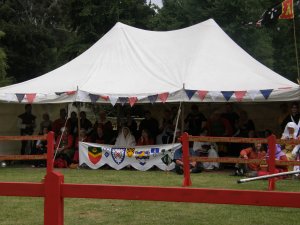
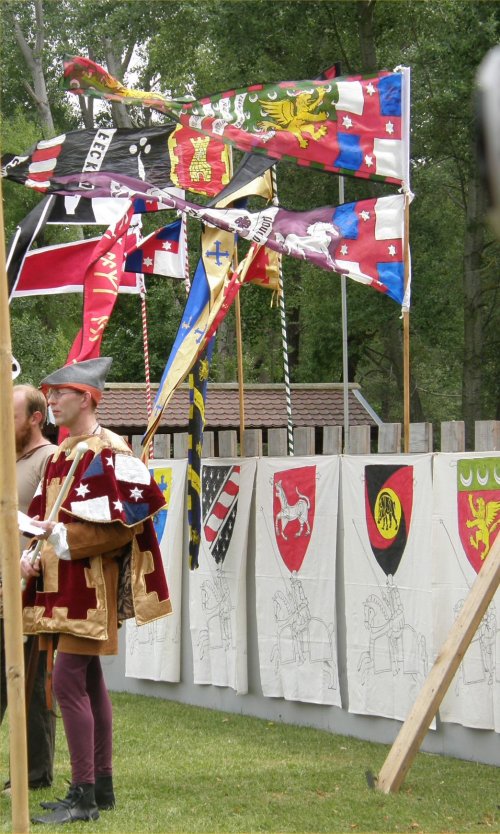
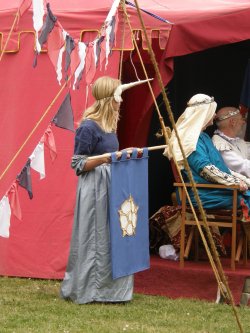
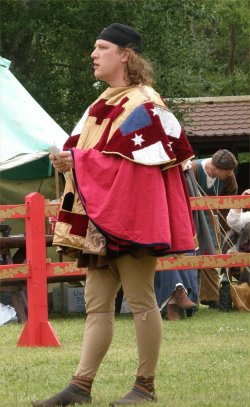
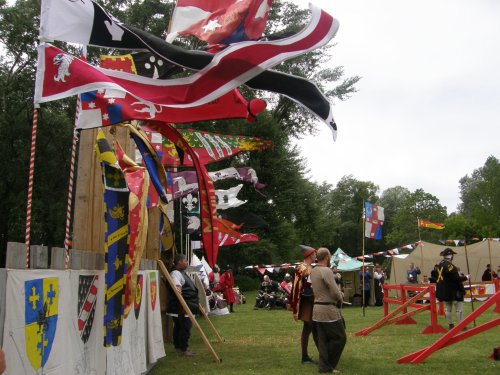 Did someone really say we had too many standards?? If you want to see them from the other side, along with the biiiig Kingdom flag, check it out
Did someone really say we had too many standards?? If you want to see them from the other side, along with the biiiig Kingdom flag, check it out 